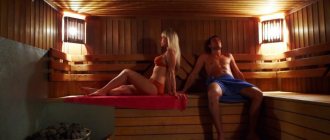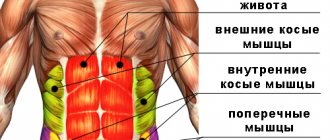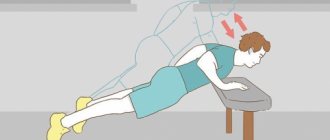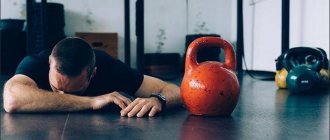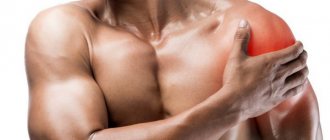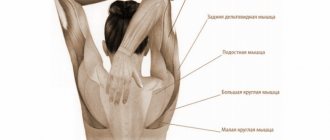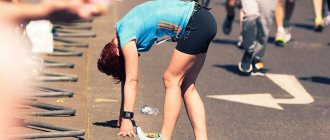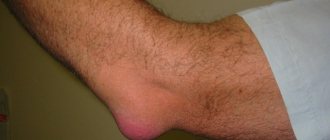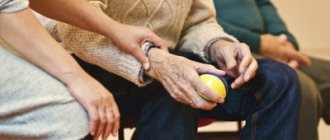- home
- Articles about training
- Muscle pain after exercise
Physical activity is beneficial for the body - this is a proven fact that does not raise doubts. Regular exercise improves well-being, quality of life, speeds up metabolism, helps maintain flexibility and mobility of the body, promotes the growth of muscle mass and increases endurance.
But all these positive aspects are slightly overshadowed by one unpleasant side effect from sports training: muscle pain of varying intensity. Pain syndrome most often occurs in beginners after the first exercises, but even if you are an experienced athlete, muscle pain probably accompanies you during periods of high-intensity loads or when performing weight-bearing exercises.
Many, having felt pain after sports activities, succumb to a common misconception and consider it a sign of a well-done workout and a manifestation of an increase in muscle mass: “it hurts, it means it’s growing.” In fact, severe muscle pain and the inability to move normally the next day, as a rule, are the result of ordinary non-compliance with the exercise technique. Let's take a closer look at what happens in the muscles during training and why pain occurs.
Muscle pain: causes and nature
The causes of muscle pain (myalgia) are varied - from emotional outbursts and infections to overtraining of the body.
If the sensations are permanent and do not disappear within 4-5 days, this is a reason to consult a doctor. The problem may be hidden. However, physical activity remains the main cause of pain.
During the session itself, as a rule, a person does not feel acute myalgia. Symptoms appear about a day later (after sleep). If your muscles hurt after training, it discourages any desire to exercise further. At the same time, if you do not reduce muscle pain and persistently continue exercising, this will lead to constant hypertonicity of the body and the risk of various diseases. If a person has difficulty climbing stairs or doing simple household chores, you need to try the best quick ways to get rid of muscle pain.
Ways to alleviate an athlete's condition
To alleviate the condition, you can take the following measures.
Reducing lactic acid concentration
When the leg muscles hurt very much after training, this means that as a result of the training, the fibers have been overstrained and excess lactic acid has stagnated in the tissues. In order for your muscles to stop hurting, you need to adhere to the following rules when performing exercises:
- It is invariably necessary to start a lesson with warm-up movements, because they are the ones that gradually prepare the body for more serious tasks.
- Lactic acid dissolves more quickly in water, so drinking plenty of fluids is extremely important. Immediately before going to the gym, you should consume up to half a liter of clean water without gas, and after that, 100-150 ml every 20-25 minutes.
- Deep and even breathing enriches the body with oxygen, which in turn promotes the rapid removal of lactic acid from tissues. Inhale deeply and as evenly as possible through your nose, and exhale better through your mouth.
- Regular visits to the gym and a gradual increase in stress on the body ensure that the substance will not accumulate in the fibers or, at least, will be quickly utilized.
- If you are wondering whether it is possible to exercise if you experience mild pain during training, the answer is: you can. You just have to halve the weight and intensity of the exercise.
- If the exercise turns out to be exhausting, do self-massage and stretching of the desired area.
Microtraumas of muscles
If the muscles hurt after the first training with a sharp and acute pain, this means that the athlete has suffered a microtrauma. This phenomenon is typical not only during the first training, but also after a long break between courses and after straining unusual muscle groups. Many people are wondering, is this good or bad? Microtraumas are the main stimulators of tissue growth. The pain from them appears the next day, and possibly on the second day after going to the gym. After just three sessions the pain disappears.
How to reduce pain after exercise
If after each workout your muscles are very sore, you need to follow a few simple recommendations:
- During the inter-training period, it is better to lead an active lifestyle.
- After each set of exercises, perform stretching and relaxing actions.
- Remember to do aerobic exercise after a series of strength exercises. The best options are exercises on an orbital track (ellipsoid), swimming and jogging.
- Decomposition products are most effectively removed by massage.
- Bath procedures help tissues recover quickly and almost painlessly.
- A warm bath with sea salt added will speed up your metabolism after training and relieve tension in the body.
Why does muscle pain occur?
In fact, there are only a few causes of pain in muscle tissue, if you do not take into account chronic diseases and pathologies. They can be divided into the following categories:
| Muscle pain due to lactic acid | During loads that are considered power, a large amount of lactic acid accumulates in the muscles. This is one of the side effects of intense training. This process causes athletes to experience unpleasant sensations of heaviness and aching pain. The substance is completely eliminated from the body within a day, so it is advisable to train not every day, but 3-4 times a week. This will give the muscles a chance to rest and recover. |
| Pain that appears late | Sometimes pain comes only 2 days after training. This is an absolutely normal process. During sports, the muscles receive new stress and tear. Microfibers heal quite quickly (2-3 days), after which, with each healing, the muscles grow and become larger in volume, provided proper nutrition and a number of other factors are observed. The main thing is to change the intensity and duration of the loads in time, and also to alternate the areas being worked, so that the part of the body in which there is pain is not worked for several days in a row. |
| Discomfort due to overtraining | If an athlete feels weakness and severe pain in the muscles (cutting or aching in nature), we can conclude that the training program was too intense. For experienced bodybuilders, this problem occurs much less frequently, because their muscles are more accustomed to stress. Professionals perceive muscle pain as a common occurrence and go away in just a couple of days. In the case of overtraining, it is important to allow the muscles to fully recover (this can take a week or more) and eat plenty of protein. |
| Pain as a consequence of injury | If the pain is numb and some areas of the body are swollen and almost impossible to touch, this may be a sign of injury. Very often, athletes use inappropriate equipment without the supervision of a coach (too much weight or incorrect execution technique), and then face the problem of injury. In this case, you cannot self-medicate. You must go to the doctor immediately. |
| Pain due to muscle hypersensitivity | If the nerve endings in the human body are very sensitive, severe muscle pain and even cramps appear due to intense sports. This process is explained by an imbalance in the body - a change in the ratio of fluid and salts in the body. Nerve endings react to the processes of change very acutely, provoking pain. In this case, stretching at the end of exercise, maintaining a drinking regime and eating foods rich in vitamins will help get rid of pain in sports. |
Amino acids and BCAA for recovery
?
- The supplement contains all amino acids (essential and non-essential) derived from whey protein.
- Category:
Amino acids
take 25 ml. before and after workout
The drug is produced in liquid form, in which the amino acids are in their free state, that is, they are absorbed faster, it is indispensable for athletes to strengthen muscle tissue tired from training, and as “fuel” during long-term stress.
?
- Designed to quickly replenish amino acid deficiency that occurs after intense training and as a result of insufficient protein intake.
- Category:
Amino acids
8 capsules immediately after training. On non-training days: 2 times a day, 4 capsules 30 minutes before meals.
AMINOMAX 6800 contains a complex of amino acids and micropeptides resulting from the hydrolysis of whey protein concentrate, with the addition of a large amount of pure L-glutamine and taurine, due to which the complex is characterized by an exemplary aminogram. AMINOMAX 6800 is also enriched with vitamin C and vitamin B6, which improve the absorption of amino acids in the body.
?
- BCAA amino acids increase performance and also help restore the body after training.
- Category:
More about the category
One serving before training. Stir 8 g of powder in 300 ml of water.
Amino acid complex Vplab “BCAA 2:1:1” is a new generation of ultramicronized essential branched-chain amino acids (BCAAs). Their distinctive features are the best solubility, rapid absorption and lack of bitterness. The anti-catabolic ratio of amino acids leucine - isoleucine - valine 2:1:1 is the most optimal for preventing the breakdown of muscle tissue, especially during weight loss. For best results, it is recommended to take BCAA amino acids before and after training.
?
- Geneticlab “BCAA Pro” is a modern sports supplement based on the essential amino acids BCAA, glutamine and a specially selected amino acid matrix, in an optimal ratio of 4:1:1.
- Category:
More about the category
mix 1 scoop per 350-400 ml of water or other drink and take 30 minutes before and immediately after training
BCAA Pro will provide energy, improve metabolism, protect muscles from catabolism and help get rid of excess fat. Your workouts will become more intense and effective.
Benefits and harm to the body
Scientists have proven that microtraumas and discomfort due to muscle pain, due to which, with the right approach, muscle growth occurs, do not always occur. They are provoked only by loads at the limit of their capabilities.
If a person, when coming to the gym, performs the same set of exercises every time, without increasing the number of repetitions in the approach or the weight of the equipment, then the body will quickly get used to it. In this case, muscle growth can not be expected.
Thus, muscle pain is a positive phenomenon, but you need to be able to feel your body. If you increase the load regularly, without paying attention to whether you managed to get rid of muscle pain after training, you can only achieve overtraining.
An unusual load can be given when enough time has passed for muscle recovery and the pain has subsided.
The degree of pain depends on the duration and intensity of the workout.
amazon.in
As a general rule, the harder and longer the workout, the more likely it is that your muscles will become sore,” says Pino. At the same time, pain may occur if you start working with a new group of muscles that are already unaccustomed to physical activity. Therefore, you need to start a new training plan slowly and gradually, no matter if you are a beginner or an experienced athlete.
“Over time, your body will begin to adapt and become stronger, so your muscles will hurt less with certain exercises. But every time you increase the intensity of your exercise, your body will naturally respond with overexertion and pain,” says Tony Gentilcore.
Types of pain
When several athletes discuss among themselves what to do with muscle pain, their opinions at this moment may differ greatly, because not all types of pain manifest themselves in the same way.
Depending on the sensitivity of the body, the level of athletic training and experience in sports, one athlete will feel a slight aching sensation, while another will have difficulty getting out of bed.
In addition, sources of discomfort may differ:
- pain as a result of “acidification” of the blood - provokes a burning sensation and goes away literally after a few hours;
- sore throat – delayed muscle pain that occurs 6-7 hours after training, but becomes especially severe only after a few days;
- traumatic pain is a syndrome caused by severe damage to ligaments, joints or muscles, which appears due to neglect of safety rules and lack of warm-up.
DOMS under a microscope
Muscle pain comes in different forms and not all of it is soreness.
So, during intense exercise for a large number of repetitions, you can feel a burning sensation in the muscles - this is the effect of lactate or lactic acid, which has nothing directly to do with DOMS. 20–40 minutes after physical activity, the lactate level returns to normal, so its effect on the muscles is out of the question after a day or two.
A pleasant nagging pain and fatigue immediately after an effective workout is also not a sore throat, but only a momentary response of the body to stress.
Severe and sharp pain when moving and persistent aching when the strained muscle is at rest may indicate an injury. Especially if the pain increases significantly with exercise and does not disappear after several repetitions or the second or third approach.
But when pain occurs 24–48 hours after physical activity, it is felt when the muscle is working, but does not bother you when it is at rest - this is classic sore throat .
Depending on the muscle group, training and stress received during training or any other physical activity, the painful state of the muscles can persist from a couple of days to a week. That is, you can, in principle, do nothing about the soreness, but just endure the pain and it will go away on its own. Or you don’t have to endure it, but we’ll talk about that a little later.
Why does delayed onset muscle pain syndrome occur ? For a long time it was believed that lactic acid, formed during anaerobic exercise, was to blame. But, as I mentioned above, and what has been proven by scientists, this is not the cause of sore throat. Within an hour, lactate levels return to normal. Although back in 1902, the phenomenon of DOMS or “muscle fever” was described by Theodore Hough, explaining it by the rupture of muscle fibers that occurs during intense physical activity. He turned out to be closest to the truth.
Now there are two relevant theories that complement each other.
The first is that soreness is the result of micro-tears of muscle fibers. The trauma is minimal to seriously excite the nervous system, but sufficient that over time the pain receptors inside the muscle connective tissue begin to react, causing those very unpleasant sensations when muscles are tense. Let me remind you that at rest there is no pain.
The second theory is called " Enzyme efflux ". The bottom line is that with microtrauma of muscle fibers, calcium from the sarcoplasmic reticulum begins to actively enter the muscles, accumulate there and do bad things. In particular, this atypical accumulation suppresses cellular respiration, slows down the transport of calcium back into the sarcoplasmic reticulum and, as a result, activates muscle protein-degrading enzymes (proteases and phospholipases). Inflammation occurs, accompanied by pain.
Somehow all this sounds complicated and alarming, but fear has big eyes. Let's understand further.
Treatment methods
Some athletes, when they want to get rid of muscle pain, mistakenly confuse joint and muscle pain.
If you continue to exercise regularly in the gym if you have a joint injury, this can lead to serious injuries. If the pain lasts more than 3 days, it is better to consult a doctor and not self-medicate.
When discomfort occurs due to too intense training, increased load, or normal soreness, which is often found among beginners, then muscle pain can be relieved with medications and folk remedies.
Pain relieving ointments and how they work
Most often, ointments are used to relieve muscle pain. Their range is extensive, and there is no shortage of inexpensive drugs with high efficiency. There are really a lot of names, so it is sometimes difficult for an unprepared person to make a choice. For serious illnesses, ointments are prescribed by general practitioners based on the diagnosis.
Local medications are also good because the side effects from their use are much less pronounced (or completely absent) compared to drugs that enter the bloodstream directly.
Most medicines have a warming effect. Due to the dilation of blood vessels, blood flows away from the damaged area. If swelling has formed at the site of injury, it decreases and blood circulation is restored. The inflammatory process gradually subsides, the muscles relax and the spasm goes away.
Another useful property of ointments is the switching of the nervous system’s attention to a local stimulus. I will explain this point in more detail. When severe pain occurs (and a joint injury is often quite painful), these sensations are transmitted to the brain, where a real source of pain is formed. The nervous system closes on it, and this greatly exhausts the body.
You can interrupt the unpleasant process using a local irritant. The product not only warms the damaged area, quickly absorbing into the skin, but also acts as an irritant due to the components included in its composition (derivatives of pepper, camphor, bee venom, and so on). Often this is enough to switch the nervous system.
There are also cooling medications. They do not have a pronounced irritating effect, but create a feeling of decreasing temperature around the affected area. They contain analgesics, menthol, essential oils, and anticoagulants. As a rule, such drugs are used immediately or shortly after injury, allowing you to quickly relieve pain.
Use of drugs
If traditional preventive measures do not help the athlete, he needs to switch to traditional medications that are designed to relieve muscle pain after training.
The use of strong anti-inflammatory drugs in sports is prohibited, especially if a person participates in sports competitions. However, there are gentler ways to relieve muscle pain after exercise. Among them are modern medicines, such as ointments, balms, aspirin, etc. Before taking pills, you should definitely consult a doctor so that he can accurately determine the cause of the pain and choose a safe remedy.
Ointments
Creams and ointments for muscle pain are quite effective remedies. They are also called an option for the lazy - apply the necessary area of the body, and wait for the result. They mainly use herbal ointments, as well as those with the addition of various oils, bile, etc. The active ingredient in the balm helps relieve muscle pain. This may be capsicam, voltaren and other active ingredients.
Pills
To relieve muscle pain after exercise, you can take painkillers such as aspirin or ibuprofen. You need to be careful about self-medication, because frequent use of these drugs causes the body to become addicted and cause very slow muscle recovery in the future. Also, these drugs are aimed only at eliminating symptoms, and not the pain itself after training, so taking pills and going to training is the worst option.
Don't forget to drink water and eat right
gifer.com
“Sleep and water are two important recovery strategies that people often overlook,” says Gentilcore. In addition to resting and drinking enough water, make sure to eat well to replenish your electrolytes. Pino points out that “protein helps repair micro-tears in the muscles, and potassium is essential for muscle contraction.”
Reducing muscle pain without drugs
When your whole body literally aches and turns out from severe muscle pain, it is not necessary to resort to medications on the first day. Time-tested techniques such as massage and proper nutrition are excellent for removing unpleasant symptoms. You just need to figure out exactly how it works.
Hot bath
If an athlete wants to reduce muscle pain after an active workout, all he needs to do is take a soothing bath. The fact is that after training, all the muscle mass in the body is maximally tense, the body is on edge. Hot water is great for reducing the feeling of overtraining and acts as a pleasant pain reliever.
A visit to a bathhouse or sauna gives the same effect.
Important: taking a bath, especially a hot one, is not recommended for people with cardiovascular problems.
Massage
Massage is also great for relieving muscle pain and discomfort after exercise. This could be a sports massage, a general massage session, or even a treatment at home. The main thing is to relax your muscles and relieve tension. This therapy is considered one of the effective ways to reduce muscle pain after exercise.
Elimination of discomfort
You can remove unpleasant sensations through physical exercise, medications and home remedies, massage, and water treatments. But in no case should you prescribe treatment on your own in case of severe injury.
Folk remedies
You can reduce the pain that occurs after heavy exertion by using alternative medicine recipes.
The following will help to relax the muscle and reduce sensations:
- local application of badger fat;
- rubbing with pepper tincture;
- applying cabbage leaf.
Use of NSAIDs
Non-steroidal anti-inflammatory drugs - Ibuprofen, Diclofenac, Celecoxib - must be taken with caution and not abused, because they slow down the body's recovery processes
Tablets help achieve only a temporary positive effect, so they cannot be used for full treatment. The use of NSAIDs negatively affects the gastrointestinal tract and liver.
Vitamin preparations
In combination with drug pain relief, multivitamins - Vitrum, Alphabet, Multi-Tabs - have a beneficial effect. They allow you to speed up recovery processes in the body. To maintain performance, it is also recommended to maintain proper nutrition.
Energy drugs
Products such as Methionine, Asparkam, and glutamic acid help restore expended resources. They contribute to the body's resistance to oxygen deficiency.
Adaptogen group
These are pantocrine, ginseng, eleutherococcus. Effective in conditions of hypoxia, increase tone, increase resistance under high loads.
Sports creams, ointments, gels
Topical preparations help activate blood circulation, relieve tone and tension, and reduce pain in joints and muscles.
The use of one or another type of ointment is determined by the nature of the damage and sensations. In case of injuries, cooling gels are suitable - Troxevasin, Efkamon, Gevkamen. They are used to relieve swelling and muscle discomfort after exercise. Another group of products - Nicoflex, Capsicam - is used to warm up the area affected by sprains. Sometimes trainees use them to prepare muscles for stress. When choosing a drug, you should consult your doctor.
Application of compresses
This pain reliever has a good effect, but it can only be used 2-3 days after a serious injury. A fairly common mistake is using a polyethylene gasket. The compress is made from a cloth moistened with the drug, spread over the entire affected area, lined with compress paper and cotton wool, and then secured with a bandage. The bandage should not be tight so as not to crush the limb.
Classic foot massage
Circular movements will help increase blood circulation and reduce pain. You can warm up your muscles using ointments. Various massagers are effective in distributing accumulated lactic acid.
Traditional methods
Drinking fresh cherry juice for several days will help relieve muscle pain after training; you can also eat the berries themselves. People have long dubbed cherries an excellent painkiller. Berries will tone the body and improve overall well-being.
If you are going to return to training in the gym after 1-2 days, the first sessions should be light so that the pain in your legs after training does not recur.
Nutrition and drinking regime
To relieve the pain that occurs after playing sports, you must also follow proper nutrition and drinking regime. According to scientific research, the main cause of discomfort after visiting the gym is dehydration of the body. To prevent this, you just need to drink more water. And in order for muscles to hurt less in case of overtraining, you need to eat right, including a sufficient amount of carbohydrates in your diet. They will relieve the feeling of weakness and tone the body.
Taking a break from training
To reduce discomfort and get rid of muscle pain, periodically practice rest from intense exercise: this is a big plus for your health.
A short break of 2-3 days will help the muscle fibers recover, in turn, progress with muscle growth will become faster.
It is also advisable to alternate the load on different muscle groups. This eliminates overtraining and takes the monotony out of your workouts.
The psychological factor is very important when playing sports, because if interest has decreased and the incentive to exercise has disappeared, you need to change the system of exercise.
How to reduce pain after exercise
To reduce pain, you must resort to the following methods:
- Massage . It allows you to disperse blood throughout the body and ensure the flow of nutrients to the right areas.
- A restorative activity. This workout involves using 50% of normal working weights with 15-20 repetitions per set, which provides blood flow to the muscles. They receive nutrients and recover faster. The point of such exercises is not only to reduce pain, but also to repeat the technique of movements, honing your skills.
- Cool down. By stretching the muscles, blood flow increases, which increases and accelerates the process of removing damaged cells, and, consequently, reduces pain.
- Proper nutrition. The diet must contain a lot of protein, the amount of which ranges from 2 to 2.5 g per 1 kg of body weight. To prevent catabolism and obtain simple amino acids, you should take BCAA. This also applies to glutamine, which also strengthens the immune system, which helps accelerate the full recovery of the body. Taking creatine can increase endurance and strength of muscle tissue by increasing the concentration of creatine phosphate.
- Have a good rest . If there is pain that prevents you from exercising, you should take a break for 2-5 days. This will allow you to fully recover and start exercising with renewed vigor.
Along with these methods, you can resort to hardening, visiting a bathhouse, sauna, using a warming ointment, and so on. These methods lead to improved blood circulation in damaged structures, which allows muscles to recover much faster.
Is it possible to exercise with muscle pain?
Many athletes who feel muscle pain the next day after training wonder whether it is possible to take a break from exercise.
If a person feels intense physical pain, this can only signal that the muscles have not recovered and need rest for 2-3 days. During this time, the body will be able to restore energy reserves.
If the pain is tolerable and is caused solely by the accumulation of lactic acid, then you can even try a short training session, skipping just one day between classes.
An easy exercise should be based on the rule: performing 1-2 exercises with two approaches. In general, the load should be 50-60 percent of normal. Such training should be carried out only by those athletes who categorically do not want to take a break and recuperate.
Should I endure or fight this pain?
You can endure it, being happy for yourself that you did a good job in the gym, but if the pain is unbearable, there is something you can do about it.
Different sources recommend various warming-massage procedures: sauna, warm shower, warm (but not hot) bath with sea salt, massage, light warming rehabilitation exercises. It is also recommended to do warm-up, cool-down and stretching after training.
All these actions are aimed at improving blood flow in the muscles, which contributes to their speedy recovery and reduction of pain.
